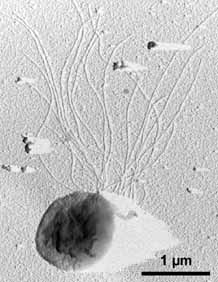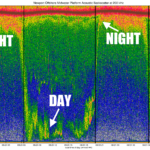 The basic energy molecule for life is ATP, adenosine triphosphate. It fuels all those cellular reactions that life needs. To produce one mol of ATP requires 70 kilojoules. That’s about 16 calories for reference. One kilojoule is near the maximum amount of solar radiation received by a square meter on Earth every second. When animals convert glucose and oxygen into water and carbon dioxide this produces 2000 kJ.
The basic energy molecule for life is ATP, adenosine triphosphate. It fuels all those cellular reactions that life needs. To produce one mol of ATP requires 70 kilojoules. That’s about 16 calories for reference. One kilojoule is near the maximum amount of solar radiation received by a square meter on Earth every second. When animals convert glucose and oxygen into water and carbon dioxide this produces 2000 kJ.
Formate is formic acid minus a hydrogen ion, i.e. CHOO− or HCOO−. The conversion of formate and water to a bicarbonate, HCO3−,and H2 at 80 ºC yields 8–20 kJ per mole. A few moles in the process and you have enough for a mol of ATP. Why on earth would an organism use this process? Because it is hell of a lot simpler than trying for glycolysis. Don’t believe m? Take a look at a few of these diagrams. I still can’t keep that @#$% straight.
Although theoretically attractive, there has been no evidence of organisms actually utilizing this pathway, mainly because it produces so little energy. That is until now. A team reports that Thermococcus onnurineus from a hydrothermal vent 1650m below the ocean’s surface off Papua New Guinea can use formate. Members of the group Thermococcus are sulfur-reducing hyperthermophilic archaea and ubiquitously present in various deep-sea hydrothermal vent systems. The researchers demonstrate that in culture with formate as the only energy source, these beasties can produce ATP. This functionality appears to reflect the presence of a gene cluster that codes for an enzyme that breaks the hydrogen/formate bond (a lyase) and various transport proteins to move both the starting ingredients and products of the reaction.
The key here is the toasty temperatures near vents often in excess of 80 ºC that makes this reaction produce energy. Previous theoretical treatments of this issue assumed the reaction would proceed at cooler temperatures more typical of other habitats where the conversion of formate would not be as profitable.
In an interesting side note recent evidence also suggests that some humans can produce energy from cleaving brain cells.
Kim, Y., Lee, H., Kim, E., Bae, S., Lim, J., Matsumi, R., Lebedinsky, A., Sokolova, T., Kozhevnikova, D., Cha, S., Kim, S., Kwon, K., Imanaka, T., Atomi, H., Bonch-Osmolovskaya, E., Lee, J., & Kang, S. (2010). Formate-driven growth coupled with H2 production Nature, 467 (7313), 352-355 DOI: 10.1038/nature09375





